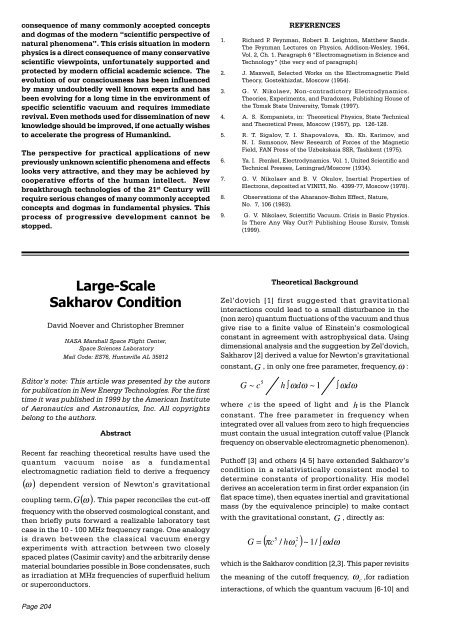Reactionless Propulsion and Active Force - Practical Guide to Free ...
Reactionless Propulsion and Active Force - Practical Guide to Free ...
Reactionless Propulsion and Active Force - Practical Guide to Free ...
You also want an ePaper? Increase the reach of your titles
YUMPU automatically turns print PDFs into web optimized ePapers that Google loves.
consequence of many commonly accepted concepts<br />
<strong>and</strong> dogmas of the modern “scientific perspective of<br />
natural phenomena”. This crisis situation in modern<br />
physics is a direct consequence of many conservative<br />
scientific viewpoints, unfortunately supported <strong>and</strong><br />
protected by modern official academic science. The<br />
evolution of our consciousness has been influenced<br />
by many undoubtedly well known experts <strong>and</strong> has<br />
been evolving for a long time in the environment of<br />
specific scientific vacuum <strong>and</strong> requires immediate<br />
revival. Even methods used for dissemination of new<br />
knowledge should be improved, if one actually wishes<br />
<strong>to</strong> accelerate the progress of Humankind.<br />
The perspective for practical applications of new<br />
previously unknown scientific phenomena <strong>and</strong> effects<br />
looks very attractive, <strong>and</strong> they may be achieved by<br />
cooperative efforts of the human intellect. New<br />
breakthrough technologies of the 21 st Century will<br />
require serious changes of many commonly accepted<br />
concepts <strong>and</strong> dogmas in fundamental physics. This<br />
process of progressive development cannot be<br />
s<strong>to</strong>pped.<br />
Page 204<br />
Large-Scale<br />
Sakharov Condition<br />
David Noever <strong>and</strong> Chris<strong>to</strong>pher Bremner<br />
NASA Marshall Space Flight Center,<br />
Space Sciences Labora<strong>to</strong>ry<br />
Mail Code: ES76, Huntsville AL 35812<br />
Edi<strong>to</strong>r’s note: This article was presented by the au<strong>to</strong>rs<br />
for publication in New Energy Technologies. For the first<br />
time it was published in 1999 by the American Institute<br />
of Aeronautics <strong>and</strong> Astronautics, Inc. All copyrights<br />
belong <strong>to</strong> the authors.<br />
Abstract<br />
Recent far reaching theoretical results have used the<br />
quantum vacuum noise as a fundamental<br />
electromagnetic radiation field <strong>to</strong> derive a frequency<br />
( ω ) dependent version of New<strong>to</strong>n’s gravitational<br />
coupling term, ( ω)<br />
G . This paper reconciles the cut-off<br />
frequency with the observed cosmological constant, <strong>and</strong><br />
then briefly puts forward a realizable labora<strong>to</strong>ry test<br />
case in the 10 - 100 MHz frequency range. One analogy<br />
is drawn between the classical vacuum energy<br />
experiments with attraction between two closely<br />
spaced plates (Casimir cavity) <strong>and</strong> the arbitrarily dense<br />
material boundaries possible in Bose condensates, such<br />
as irradiation at MHz frequencies of superfluid helium<br />
or superconduc<strong>to</strong>rs.<br />
REFERENCES<br />
1. Richard P. Feynman, Robert B. Leigh<strong>to</strong>n, Matthew S<strong>and</strong>s.<br />
The Feynman Lectures on Physics, Addison-Wesley, 1964,<br />
Vol. 2, Ch. 1. Paragraph 6 “Electromagnetism in Science <strong>and</strong><br />
Technology” (the very end of paragraph)<br />
2. J. Maxwell, Selected Works on the Electromagnetic Field<br />
Theory, Gostekhizdat, Moscow (1954).<br />
3. G. V. Nikolaev, Non-contradic<strong>to</strong>ry Electrodynamics.<br />
Theories, Experiments, <strong>and</strong> Paradoxes, Publishing House of<br />
the Tomsk State University, Tomsk (1997).<br />
4. A. S. Kompaniets, in: Theoretical Physics, State Technical<br />
<strong>and</strong> Theoretical Press, Moscow (1957), pp. 126-128.<br />
5. R. T. Sigalov, T. I. Shapovalova, Kh. Kh. Karimov, <strong>and</strong><br />
N. I. Samsonov, New Research of <strong>Force</strong>s of the Magnetic<br />
Field, FAN Press of the Uzbekskaia SSR, Tashkent (1975).<br />
6. Ya. I. Frenkel, Electrodynamics. Vol. 1, United Scientific <strong>and</strong><br />
Technical Presses, Leningrad/Moscow (1934).<br />
7. G. V. Nikolaev <strong>and</strong> B. V. Okulov, Inertial Properties of<br />
Electrons, deposited at VINITI, No. 4399-77, Moscow (1978).<br />
8. Observations of the Aharanov-Bohm Effect, Nature,<br />
No. 7, 106 (1983).<br />
9. G. V. Nikolaev, Scientific Vacuum. Crisis in Basic Physics.<br />
Is There Any Way Out?! Publishing House Kursiv, Tomsk<br />
(1999).<br />
Theoretical Background<br />
Zel’dovich [1] first suggested that gravitational<br />
interactions could lead <strong>to</strong> a small disturbance in the<br />
(non zero) quantum fluctuations of the vacuum <strong>and</strong> thus<br />
give rise <strong>to</strong> a finite value of Einstein’s cosmological<br />
constant in agreement with astrophysical data. Using<br />
dimensional analysis <strong>and</strong> the suggestion by Zel’dovich,<br />
Sakharov [2] derived a value for New<strong>to</strong>n’s gravitational<br />
constant, G , in only one free parameter, frequency,ω :<br />
G ~ c h ∫ωdω ~ 1 ∫ωdω<br />
5<br />
where c is the speed of light <strong>and</strong> h is the Planck<br />
constant. The free parameter in frequency when<br />
integrated over all values from zero <strong>to</strong> high frequencies<br />
must contain the usual integration cu<strong>to</strong>ff value (Planck<br />
frequency on observable electromagnetic phenomenon).<br />
Puthoff [3] <strong>and</strong> others [4 5] have extended Sakharov’s<br />
condition in a relativistically consistent model <strong>to</strong><br />
determine constants of proportionality. His model<br />
derives an acceleration term in first order expansion (in<br />
flat space time), then equates inertial <strong>and</strong> gravitational<br />
mass (by the equivalence principle) <strong>to</strong> make contact<br />
with the gravitational constant, G , directly as:<br />
5 2 ( πc / hω<br />
) ~ 1 ωdω<br />
G = c / ∫<br />
which is the Sakharov condition [2,3]. This paper revisits<br />
the meaning of the cu<strong>to</strong>ff frequency, ω c ,for radiation<br />
interactions, of which the quantum vacuum [6-10] <strong>and</strong>

















